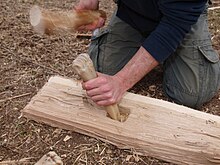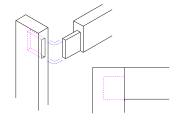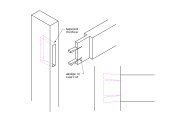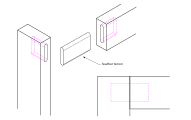Mortise and tenon



A mortise and tenon (occasionally mortice and tenon) joint connects two pieces of wood or other material. Woodworkers around the world have used it for thousands of years to join pieces of wood, mainly when the adjoining pieces connect at right angles.
Mortise and tenon joints are strong and stable joints that can be used in many projects. They connect by either gluing or friction-fitting into place. The mortise and tenon joint also gives an attractive look. One drawback to this joint is the difficulty in making it because of the precise measuring and tight cutting required. In its most basic form, a mortise and tenon joint is both simple and strong. There are many variations of this type of joint, and the basic mortise and tenon has two components:
- the mortise hole, and
- the tenon tongue.
The tenon, formed on the end of a member generally referred to as a rail, fits into a square or rectangular hole cut into the other, corresponding member. The tenon is cut to fit the mortise hole exactly. It usually has shoulders that seat when the joint fully enters the mortise hole. The joint may be glued, pinned, or wedged to lock it in place.
This joint is also used with other materials. For example, it is traditionally used by both stonemasons and blacksmiths.
Etymology
[edit]The noun mortise, "a hole or groove in which something is fitted to form a joint", comes from c. 1400 from Old French 'mortaise' (13th century), possibly from Arabic 'murtazz', "fastened", past participle of 'razza', "cut a mortise in".[1] The word tenon, a noun in English since the late 14th century, developed its sense of "a projection inserted to make a joint" from the Old French 'tenir' "to hold".[2]
History and ancient examples
[edit]
The mortise and tenon joint is an ancient joint. One of the earliest mortise-tenon structure examples dates back 7,000 years to the Hemudu culture in China's Zhejiang Province.[3] Tusked joints were found in a well near Leipzig,[4] created by early Neolithic Linear Pottery culture, and used in construction of the wooden lining of the wells.[5] Mortise and tenon joints have also been found joining the wooden planks of the "Khufu ship",[6] a 43.6 m (143 ft) long vessel sealed into a pit in the Giza pyramid complex of the Fourth Dynasty around 2500 BC. They were also found in the Uluburun shipwreck (14th century BC).[7]

Mortise and tenon joints have also been found in ancient furniture from archaeological sites in the Middle East, Europe and Asia. Many instances are found, for example, in ruins of houses in the Silk Road kingdom of Cadota, dating from the first to the 4th century BC.[8] In traditional Chinese architecture, wood components such as beams, brackets, roof frames, and struts were made to interlock with perfect fit, without using fasteners or glues, enabling the wood to expand and contract according to humidity.[9] Archaeological evidence from Chinese sites shows that, by the end of the Neolithic, mortise and tenon joinery was employed in Chinese construction.[10]
The thirty sarsen stones of Stonehenge were dressed and fashioned with mortise and tenon joints before they were erected between 2600 and 2400 BC.[11]
A variation of the mortise and tenon technique, called Phoenician joints (from the Latin coagmenta punicana)[12][13] was extensively used in ancient shipbuilding to assemble hull planks and other watercraft components together. It is a locked (pegged) mortise and tenon technique that consists of cutting two mortises into the edges of two planks; a separate rectangular tenon is then inserted in the two mortises. The assembly is then locked in place by driving a dowel through one or more holes drilled through mortise side wall and tenon.[14][15]
Description
[edit]Generally, the size of the mortise and tenon is related to the thickness of the timbers. It is good practice to proportion the tenon as one third the thickness of the rail, or as close to this as is practical. The haunch, the cut-away part of a sash corner joint that prevents the tenon coming loose, is one third the length of the tenon and one-sixth of the width of the tenon in its depth. The remaining two-thirds of the rail, the tenon shoulders, help to counteract lateral forces that might tweak the tenon from the mortise, contributing to its strength. These also serve to hide imperfections in the opening of the mortise.
Types
[edit]
Mortises
[edit]

A mortise is a hole cut into a timber to receive a tenon. There are several kinds of mortise:[16]
- Open mortise: a mortise that has only three sides. (See bridle joint).
- Stub mortise: a shallow mortise, the depth of which depends on the size of the timber; also a mortise that does not go through the workpiece (as opposed to a "through mortise").
- Through mortise: a mortise that passes entirely through a piece.
- Wedged half-dovetail: a mortise in which the back is wider, or taller, than the front, or opening. The space for the wedge initially leaves room to insert the tenon. The wedge, after the tenon is engaged, prevents its withdrawal.
- Through-wedged half-dovetail: a wedged half-dovetail mortise that passes entirely through the piece.
Tenons
[edit]
A tenon is a projection on the end of a timber for insertion into a mortise. Usually, the tenon is taller than it is wide. There are several kinds of tenons:
- Stub tenon: a short tenon, the depth of which depends on the size of the timber; also a tenon that is shorter than the width of the mortised piece so the tenon does not show (as opposed to a "through tenon").
- Through tenon: a tenon that passes entirely through the piece of wood it is inserted into, being clearly visible on the rear side.
- Loose tenon: a tenon that is a separate part of the joint, as opposed to a fixed tenon that is an integral part of one of the pieces to be joined.
- Biscuit tenon: a thin oval piece of wood, shaped like a biscuit[17]
- Pegged (or pinned) tenon: the joint is strengthened by driving a peg or dowel pin (treenail) through one or more holes drilled through the mortise side wall and tenon;[18] this is common in timber framing joints.
- Tusk tenon: a kind of mortise and tenon joint that uses a wedge-shaped key to hold the joint together.
- Teasel (or teazle) tenon: a term used for the tenon on top of a jowled or gunstock post, which is typically received by the mortise in the underside of a tie beam. A common element of the English tying joint.
- Top tenon: the tenon that occurs on top of a post.
- Hammer-headed tenon: a method of forming a tenon joint when the shoulders cannot be tightened with a clamp.
- Half shoulder tenon: an asymmetric tenon with a shoulder on one side only. A common use is in framed, ledged, and braced doors.
Gallery
[edit]-
A traditional through, wedged, mortise and tenon joint
-
A stub tenon corner joint
-
A haunched stub tenon corner joint
-
A foxtail wedged tenon joint
-
A pinned corner tenon joint
-
A modern feather tenon joint (primarily called a loose tenon)
See also
[edit]References
[edit]- ^ Harper, Douglas. "mortise". Online Etymology Dictionary. Retrieved 2019-02-19.
- ^ Harper, Douglas. "tenon". Online Etymology Dictionary. Retrieved 2019-02-19.
- ^ "Across China: Ancient woodworking technique revived in modern times - Xinhua | English.news.cn". www.xinhuanet.com. Retrieved 2024-03-26.
- ^ "The Neolithic Toolkit". Archaeology.org. Retrieved 7 January 2015.
- ^ Early Neolithic Water Wells Reveal the World's Oldest Wood Architecture Tegel W, Elburg R, Hakelberg D, Stäuble H, Büntgen U (2012) Early Neolithic Water Wells Reveal the World's Oldest Wood Architecture. PLoS ONE 7(12): e51374. doi:10.1371/journal.pone.0051374
- ^ Ward, Cheryl. "World's Oldest Planked Boats," in Archaeology (Volume 54, Number 3, May/June 2001). Archaeological Institute of America.
- ^ Pulak, Cemal (1998). "The Uluburun Shipwreck: An Overview". The International Journal of Nautical Archaeology. 27 (3): 210. doi:10.1111/j.1095-9270.1998.tb00803.x.
Pegged mortise-and-tenon joints similar to those used in Graeco-Roman ships of later centuries fasten its planks together and to the keel.
- ^ Roberts, Rachel (2012). "House-building in Ancient Niya". IDP News. 39. Retrieved 26 October 2012.
- ^ Steinhardt, Nancy W. (2002). Chinese Architecture (English ed.). Yale University Press. pp. 1. ISBN 978-0-300-09559-3.
- ^ Xujie, Liu (2002). Chinese Architecture - The Origins of Chinese Architecture (English ed.). Yale University Press. pp. 11. ISBN 978-0-300-09559-3.
- ^ "Building Stonehenge". English Heritage. Retrieved 2020-10-27.
- ^ Cato, Marcus (1934) [c. 160 BC]. "XVIII". De agri cultura [On agriculture] (in Latin). Translated by Henderson, Jeffrey. Loeb Classical Library. Retrieved 2021-04-27.
- ^ Sleeswyk, A. W. (1980-08-01). "Phoenician joints, coagmenta punicana". International Journal of Nautical Archaeology. 9 (3): 243–244. doi:10.1111/j.1095-9270.1980.tb01303.x. ISSN 1057-2414.
- ^ López-Ruiz, Carolina; Doak, Brian R. (2019-07-29). The Oxford Handbook of the Phoenician and Punic Mediterranean. Oxford University Press. ISBN 978-0-19-049935-8.
- ^ Teague, Matthew (2007-05-01). "The Pegged Joint, Exposed". FineWoodworking. Taunton Press. Archived from the original on 2020-09-25. Retrieved 2021-04-28.
- ^ Dekker, Michael. "Mortise-and-Tenon". Woodwork Details. Retrieved 2015-02-18.
- ^ "Our Reviews, Your Decision". Man Of Family. Retrieved 2017-07-28.
- ^ Teague, Matthew (May 2007). "The Pegged Joint, Exposed". Fine Woodworking. Taunton Press. Retrieved 2015-02-18.
- This article is partly based on a Quicksilver wiki article at A Glossary of Terms For Traditional Timber Framing (Timberbee) under the terms of the GNU Free Documentation License.







